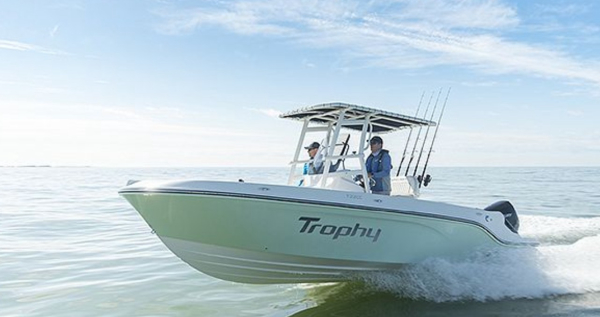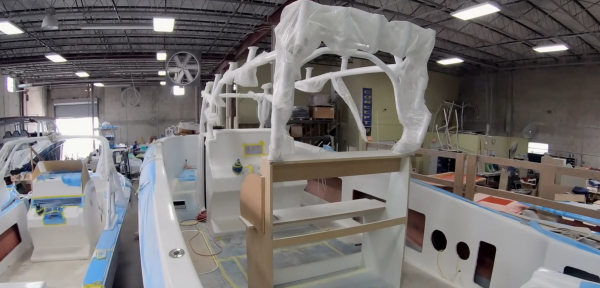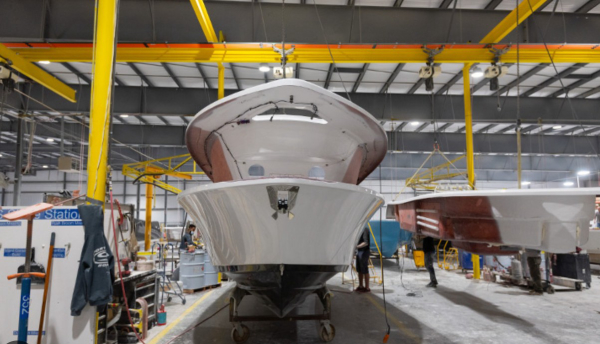
Brunswick’s announcement this week that it will close its long-running Reynosa, Mexico, fiberglass boat plant and consolidate production back into U.S. facilities — while simultaneously shuttering a Flagler Beach, Florida, plant and moving that output to nearby Edgewater — feels like a jolt to an industry that has, for two decades, mostly nodded toward Mexico and other low-cost regions for mass fiberglass boat production.
The move is striking not because reshoring is unheard of, but because it happens at the same time other manufacturers have recently expanded abroad, creating an apparent paradox: some builders chase lower labor costs overseas even as a giant of the industry brings work back home—maybe not coincidentally at the same time Washington is calling for such moves in major industry.
For Brunswick, the public explanation is straightforward. The company says it’s an efficiency play: shifting models built in Reynosa into higher-performing U.S. operations in Vonore, Tennessee, and Merritt Island, Florida, while offering affected Flagler Beach employees transfers to Edgewater.
The transition is expected to finish by summer 2026 and create more than 200 new U.S. manufacturing jobs. It will, of course, eliminate many good jobs south of the border but given that good-paying, labor-intensive jobs are difficult to find in the U.S., the change seems synched to the times—provided there are plenty of U.S. workers willing to do them.
At the same time, some other marine industry players are moving in the opposite direction. BRP — the Canadian recreational-vehicle and marine conglomerate — has broken ground on a major new boat production facility in Chihuahua, Mexico. It’s a massive investment expected to boost capacity and create thousands of jobs.
Trade publications note that BRP is far from alone: over the past decade, an array of fiberglass and small-boat assembly work has landed in Mexico, while European yards, especially in Poland, have become vital suppliers for Continental brands.
One of the most notable U.S. examples is Warbird Marine Holdings, parent company of Invincible Boats and Yellowfin. In 2021, the company set up an interim production facility in Yucatán, Mexico, to ease labor shortages and cost pressures at home while keeping pace with demand for big offshore center consoles.

The Yucatán workforce offered modern infrastructure, lower wages, and a willingness to train to U.S. standards, per the company. By 2023, Warbird inaugurated a permanent plant there to produce a significant share of its larger models for export back to the U.S. Company executives stressed the move was about balancing capacity and finding enough capable workers willing to do the job right—something they said was challenging in south Florida.
Invincible’s Yucatán venture did spark some quiet skepticism among American buyers about whether boats built south of the border would measure up. The company responded with assurances that Mexico-built models go through the same engineering pipeline and inspections as Florida-built ones, with hulls, hardware, and rigging specified by U.S. design teams. Mexican crews were trained by seasoned Florida boatbuilders, and dealers say most buyers no longer ask once they see the boats.
Mexico’s labor costs remain far below the U.S. for hard, dirty, hand-intensive work such as laminating hulls and stringers. Its location also shortens freight and delivery times compared with offshore sources like Asia. For brands selling entry-level runabouts, pontoons, or aluminum boats, offshore production often makes the difference between hitting a competitive price point and missing the market.
But the math is shifting. Rising freight rates, supply-chain volatility since the pandemic, and new automation technologies in U.S. yards have narrowed the cost gap. Tariffs and trade policy uncertainty have also complicated long-term planning over the last nine months. Reshoring can bring political goodwill, tax incentives, and a reputation boost from investing in American jobs. Brunswick leaned heavily on those themes in announcing its return, suggesting the company sees more stability in a tightly managed U.S. footprint.

In boom times, investing in U.S. plants pays off; when the market softens—as it always does for boat-building is one of the most cyclical of industries--offshore facilities help defend margins. Currency shifts can make Mexico particularly attractive when the peso is weak, while energy costs and incentives may swing the pendulum back toward the U.S.
Brand positioning may be the final arbiter. Premium builders that market “Made in USA” or “handcrafted in Europe” are willing to absorb higher costs to protect their identity. Volume brands catering to first-time buyers or family pontoons must guard every dollar in production costs.
What does it all mean the U.S. boating industry? Much smarter folks than me will have to figure that out, but likely a more mixed global footprint, not a clear swing one way or the other. Brunswick’s reshoring may spark political talk and set an example, but BRP, Warbird, and European yards demonstrate that globalization is alive and well. Manufacturers will continue weighing labor, automation, logistics, and marketing as they place hulls on the line.
— Frank Sargeant
Frankmako1@gmail.com